Physical Address
304 North Cardinal St.
Dorchester Center, MA 02124
Acute pancreatitis (AP) has an excellent prognosis if the severity is limited, and if the underlying cause can be identified and treated. However, AP may recur if the underlying causes are not eliminated or modified. Patients with recurrent AP (RAP) endure frequent emergency room (ER) visits and hospitalizations, costly testing, potentially risky interventions, and may eventually develop chronic pancreatitis (CP) and related functional impairment. Thus, RAP has a detrimental impact on quality of life and places a tremendous cost burden on health care systems. The central clinical objective is to evaluate and treat the causes of RAP to interrupt the disease process. In this chapter, the evaluation and treatment of RAP are reviewed, with an emphasis on the appropriate role of endoscopy.
The diagnosis of AP can be established based on two of the following: (1) typical pancreatic pain, (2) elevation in serum lipase and/or amylase levels to greater than 3 times the upper limit of normal, and (3) confirmatory imaging findings. The term RAP is found in the literature dating back seven decades. RAP is defined as “two or more episodes of AP.” Reasonable stipulations have been imposed on this basic definition, including full resolution of symptoms between attacks, the absence of imaging changes indicating CP, and a period of at least 3 months between the initial and recurrent episode(s). The latter criterion is used to distinguish true recurrence from a complication from the initial attack or an exacerbation related to dietary advancement. The term idiopathic RAP (IRAP) is used when the cause is not immediately recognized based on history, physical examination, basic laboratory testing (e.g., serum triglyceride and calcium), and imaging tests (transabdominal ultrasound [TAUS] and/or computed tomography [CT] scan). Patients with IRAP are at risk for further attacks and progression to CP. In efforts to find obscure causes and cure the disease, they may undergo second-line imaging tests, endoscopic retrograde cholangiopancreatography (ERCP), and genetic testing. Even after these advanced tests have been performed and thousands of dollars have been spent, the cause may remain unexplained or unmodifiable, and attacks or persistent intractable pain may persist with or without morphologic evidence of CP. The term true idiopathic recurrent acute pancreatitis (TIRAP) has been coined for such unfortunate patients. An axiom of RAP and CP is that the symptom burden, especially chronic pain, correlates poorly with morphologic changes. Some patients with frequent attacks or intractable pain between attacks even undergo total pancreatectomy with autologous islet cell transplantation as a last resort, despite the absence of morphologic or functional evidence of CP.
The incidence of AP ranges from 13 to 45/100,000. In 2012, AP accounted for 330,561 ER visits and 275,170 hospitalizations, with a related aggregate cost of $2.6 billion. Multiple observational studies have included consecutive patients followed after an index bout of AP to ascertain the rates of RAP and progression to CP. A 2015 meta-analysis showed a pooled recurrence rate of 22% (95% confidence interval [CI] 18%–26%) in 11 studies. The pooled rate of progression from RAP to CP was 36% (CI 20%–53%) in five studies. The prevalence rates of RAP and CP were higher in alcohol-related compared to biliary pancreatitis. The results for other etiologies and idiopathic pancreatitis are not always reported. However, some studies have shown higher recurrence and progression rates in those with idiopathic compared to biliary etiology.
The causes of RAP and CP overlap, and have been categorized as toxic and metabolic, genetic, autoimmune, and obstructive ( Table 57.1 ). Several etiologies particularly relevant to endoscopists are discussed in the following sections.
| Etiology | Clinical Clues/Risk Factors | |
|---|---|---|
| Toxic | Alcohol | Heavy regular or binge alcohol consumption |
| Cigarette smoking | ||
| Cannabis | ||
| Metabolic | Hypertriglyceridemia | Familial lipid disorders, poorly controlled diabetes, obesity, excess estrogen, hypothyroidism, alcohol abuse |
| Hypercalcemia | Hyperparathyroidism | |
| Obstructive | Cholelithiasis/choledocholithiasis | Rapid weight loss/gain, pregnancy, obesity, preceding biliary colic |
| Microlithiasis | Elevated liver function tests during episode | |
| Sphincter of Oddi dysfunction | Postcholecystectomy, use of opiates | |
| IPMN | Most common with main duct involvement | |
| Pancreatic cancer | New onset of RAP, age > 40 years, weight loss | |
| Chronic pancreatitis | Presence of ductal stones/strictures | |
| Upper GI Crohn's disease | History of Crohn's disease | |
| Pancreas divisum | Dorsal duct dilation or Santorinicele on imaging | |
| Duodenal duplication cyst | ||
| Juxtapapillary diverticulum | ||
| Genetic | CFTR | Recurrent sinusitis/bronchitis, male infertility |
| SPINK-1 | ||
| PRSS1 | Multiple family members in consecutive generations with pancreatitis and/or pancreatic cancer | |
| Infectious | Ascariasis | |
| Viral (mumps, coxsackie A) | ||
| Autoimmune/Vascular | Type 1 AIP (IgG4-related sclerosing disease) | Typical imaging findings (pancreatic enlargement, capsular enhancement, ductal strictures) Other organ involvement (salivary glands, retroperitoneal fibrosis, renal cortical lesions, etc.) Elevated IgG4 |
| Type 2 AIP | History of IBD | |
| Lupus-associated pancreatitis | ||
| Medications | Azathioprine, furosemide, valproic acid | Short latency from onset of medication to onset of attack, literature supportive of relationship, positive rechallenge |
* T oxic and Metabolic, I diopathic, G enetic, A utoimmune, R ecurrent and Severe Acute Pancreatitis Associated Chronic Pancreatitis, O bstructive.
Biliary microlithiasis is a common cause of IRAP in patients who have an intact gallbladder, particularly those with risk factors such as pregnancy, rapid weight loss, critical illness, prolonged fasting, ceftriaxone use, octreotide use, bone marrow or organ transplant, and prolonged fasting. Microlithiasis refers to small gallstones (e.g., < 3 mm) that are not easily visible on TAUS but may easily traverse the cystic duct and impact at the ampulla of Vater. Recurrent passage of small stones may produce an inflammation and fibrosis cycle resulting in ampullary stenosis, which increases susceptibility to obstructive AP episodes. Though microlithiasis is “invisible” on TAUS, it may coincide with the presence of biliary sludge, which is more easily seen on TAUS, repeat TAUS, and endoscopic ultrasound (EUS). Biliary sludge is a mixture of particulate matter, mucous, and bile, and is visible as nonshadowing echogenic material that forms layers in the dependent portion of the gallbladder. Sludge visible on EUS may not always contain stones, but may be a reasonable biomarker to guide treatment. Two studies showed high rates of sludge or biliary crystals (67%–74%) in patients with IRAP and intact gallbladders. In general, we consider both findings of microlithiasis or sludge visible on TAUS/EUS or the presence of crystals in the bile to indicate biliary pancreatitis, caused by passage of particulate material that causes transient ampullary obstruction.
The diagnostic workup for microlithiasis and the threshold for an empiric cholecystectomy have been sources of some controversy. EUS may be more sensitive for detecting sludge and microlithiasis than TAUS, CT, and magnetic resonance cholangiopancreatography (MRCP) ( Fig. 57.1 ). Some use cholecystokinin stimulation with endoscopic collection of expressed bile and polarized microscopy to check for crystals. This method is performed infrequently because of questionable specificity and reproducibility.
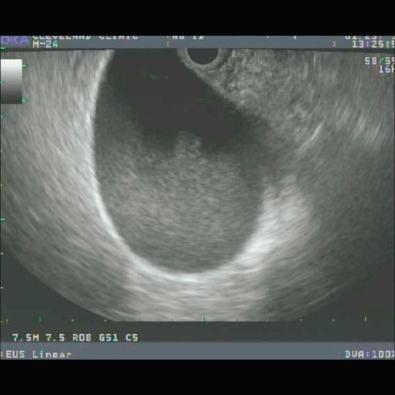
Cholecystectomy is the definitive and currently preferred treatment for suspected microlithiasis. A practical approach advocated by many experts is to proceed to empiric cholecystectomy in those with TIRAP and intact gallbladder. Some have even advocated this intervention after a first attack. A 2015 interventional trial randomized patients experiencing their first attack of idiopathic AP to empiric cholecystectomy versus watchful waiting. Baseline TAUS was negative for stones in all patients. The cholecystectomy group had significantly lower rates of recurrence compared to the observation group (8/39 vs. 23/46, p = 0.016) after a mean of 36 months of follow-up. The number-needed-to-treat with cholecystectomy to prevent one patient from having a recurrence was five. The use of empiric cholecystectomy in IRAP should be considered carefully based on the patient's clinical presentation and risk factors. For example, in a young, thin patient with IRAP who has normal liver function tests and whose gallbladder appears normal on ultrasonography, it would be prudent to first obtain genetic testing for pancreatitis-causing mutations. The finding of a significant high penetrance mutation (e.g., in PRSS1 ) may obviate cholecystectomy.
Endoscopic biliary sphincterotomy (EBS) is an effective alternative for selected patients. The rationale for performing EBS is that it separates the biliary and pancreatic orifices, allowing crystals and stones to pass into the duodenum with less chance of causing pancreatic duct obstruction or biliary reflux. In observational studies, EBS has been shown to decrease the rate of recurrence of biliary pancreatitis in patients with intact gallbladders to 2% to 6%. EBS can be considered for very elderly patients, those with comorbidities increasing operative risk, those refusing cholecystectomy, or as a temporizing strategy if cholecystectomy is delayed. The use of EBS has waned since the advent of laparoscopic cholecystectomy, which may be safer than ERCP in this cohort of patients.
Pancreas divisum (PD) is a relatively common embryological anatomic variant that has been postulated to impair drainage of the pancreatic duct, contributing to obstructive pancreatitis. The pancreas begins as dorsal and ventral buds, each with separate ductal drainage into the foregut. Within the first trimester, the ventral bud rotates axially and fuses with the dorsal part. In most cases, the dorsal and ventral ducts likewise fuse, allowing redundant drainage of the entire pancreas through both minor and major papillae. In cases of PD, the ductal systems do not fuse, leading to separate drainage of the dorsal and ventral ducts, or only partially fuse (incomplete divisum), resulting in the presence of a thread-like connection between the systems ( Fig. 57.2 ). Because the minor papilla is a smaller opening, patients with PD may suffer RAP affecting the dorsal pancreas (superior head, body, and tail of pancreas). Patients with PD are protected from biliary pancreatitis due to lack of continuity between the biliary and pancreatic ducts. As such, the diagnosis of PD may obviate empiric cholecystectomy in patients with IRAP. A rare exception is focal ventral gallstone pancreatitis, which may still occur in PD patients.
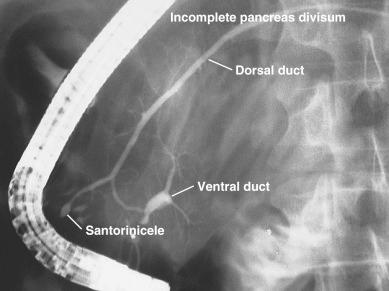
The traditional gold standard for diagnosing PD has been ERCP. Cannulation and injection of the ventral pancreatic duct via the major papilla reveals a short, arborized ventral duct ( Fig. 57.3 ). It is important to recognize that the finding of a short ventral duct may also indicate a benign or malignant pancreatic duct stricture. Observance of ventral duct arborization may prompt subsequent endoscopic cannulation and injection of the minor papilla to define the dorsal duct anatomy and allow endoscopic therapy. ERCP is now rarely needed for diagnosis of PD since the advent of MRCP, secretin-enhanced MRCP, and EUS. In most cases, endoscopists have a diagnostic MRCP available and undertake ERCP with therapeutic intent.
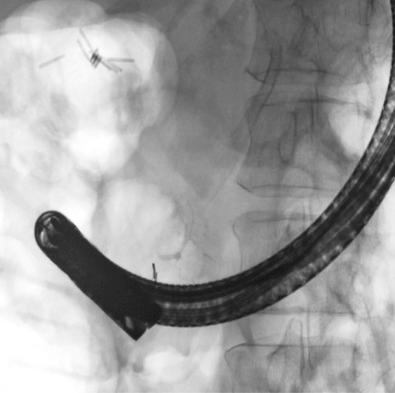
The decision to intervene in cases of PD must be considered carefully. PD is common, and its presence does not always indicate that it is a cause of or cofactor in IRAP. A comprehensive analysis of autopsy, ERCP, and MRCP studies suggest that the prevalence of PD in the general Western population is 8%. PD is less common in African Americans (1%–2%) and Asians (1.5%). Whether this common anomaly is a true cause of IRAP continues to be debated. Favoring causation are ERCP studies that show increased rates of PD among those with IRAP and CP compared to controls. However, a 2011 review highlights several biases that may explain these differences.
Multiple retrospective and prospective studies have suggested that endoscopic therapy consisting of minor papillotomy or transpapillary dilation decreases the frequency of RAP or improves pain ( Table 57.2 ). However, many of these studies are limited by significant patient heterogeneity, small sample size, limited duration of follow-up, and lack of comparison groups. Recent studies have also found that genetic mutations may confound the relationship of PD and pancreatitis. In a case-control study, patients with idiopathic pancreatitis had the same prevalence of PD as controls (7%), whereas the prevalence of PD was significantly higher in IRAP/CP patients with serine protease inhibitor Kazal type-1 ( SPINK-1 ) (16%) and cystic fibrosis transmembrane conductance regulator ( CFTR ) mutations (47%). The authors concluded there was an association of PD with these genetic defects in patients with IRAP and CP, and that PD was acting as a “partner” in the genesis of pancreatitis. This latter argument (that PD is a cofactor) has been questioned by some who believe that PD does not cause pancreatitis. They have argued that PD may be an “innocent bystander” in what is really a genetic problem. In light of these controversies, deciding which patients are most likely to benefit from endoscopic treatment is a frequent clinical conundrum. Signs of impaired dorsal duct drainage (e.g., dorsal duct dilation, the presence of a Santorinicele, which is a saccular dilation of the terminal duodenal portion of the dorsal pancreatic duct [ Fig. 57.4 ], focal inflammation or fibrosis of the dorsal pancreas, and decreased duodenal filling after secretin), may favor causation.
| Author (Year) | Study Design | No. | Mean Follow-Up (mo) | Intervention | SYMPTOM RELIEF | Restenosis | Chronic Duct Changes | |||
|---|---|---|---|---|---|---|---|---|---|---|
| NP | ARP | CP | CAP | |||||||
| Russell et al. (1984) | Retro | 5 | 8 | MES | 1/5 | 2/2 | 4/4 | NP | ||
| Soehendra et al. (1986) | Retro | 6 | 3 | MES | 5/8 | NP | ||||
| Liquory et al. (1986) | Retro | 8 | 24 | MES | 3/8 | |||||
| McCarthy et al. (1988) | Retro | 19 | 6–36 | Stent | 17/19 | 2/19 | ||||
| Prabhu et al. (1989) | Retro | 18 | 12–60 | Stent | 15/18 | NS | ||||
| Siegel et al. (1990) | Retro | 31 | 24 | Stent | 26/31 | NS | ||||
| Lans et al. (1992) | RCT | 10 (9 controls) | 29 | Stent | 9/10 | 0/10 | ||||
| Sherman et al (1994) | RCT | 16 (17 controls) | 25 | MES | 7/16 | NP | ||||
| Lehman et al. (1993) | Retro | 52 | 20 | MES | 13/17 | 3/11 | 6/24 | 10/18 | ||
| Coleman et al. (1994) | Retro | 34 | 23 | Stent | 7/9 | 12/20 | 2/5 | NP | NS | |
| Kozarek et al. (1995) | Retro | 39 | 26 | MES and/or stent | 11/15 | 6/19 | 1/5 | 3/26 | 10/39 | |
| Boerma et al. (2000) | Prosp | 16 | 51 | Stent | 5/16 | NS | ||||
| Ertan (2000) | Prosp | 25 | 24 | Stent | 19/25 | 21/25 | ||||
| Heyries et al. (2002) | Prosp | 24 | 39 | MES or Stent | 22/24 | NS | 16/16 | |||
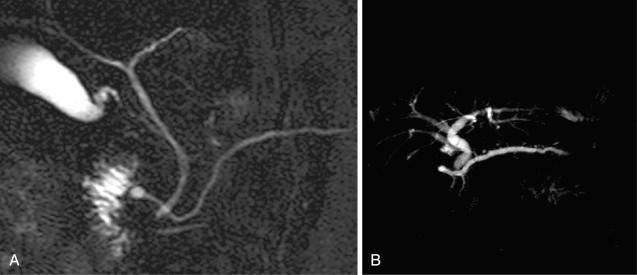
Endoscopic therapy for PD involves minor papillotomy to enhance dorsal duct drainage ( Fig. 57.5 ). After minor papillotomy, a temporary pancreatic stent is usually placed to maintain patency of the orifice during healing and as prophylaxis against post-ERCP pancreatitis. Minor papilla localization and cannulation to achieve dorsal duct access can be challenging. The minor papilla is situated proximally and to the right of the major papilla, and is often best visualized from a long scope position. The minor papilla sometimes appears as a small mound or “mini-papilla,” but in other cases is quite flat with an almost invisible orifice. Localization of the orifice may be aided by intravenous secretin injection, which stimulates pancreatic juice production, causing the orifice to open. Methylene blue sprayed over the surrounding mucosa can be a useful adjunct. After secretin is administered, the brisk pancreatic flow washes clear the blue dye surrounding the orifice, producing a visible blush for targeted cannulation. Smaller tapered catheters loaded with hydrophilic 0.021-inch wires are best for these cases. It is best to cannulate with the wire because probing with the catheter may cause trauma and bleeding, which can impair localization. After the duct is engaged successfully with a wire and then with the catheter, great care must be taken in passing the wire to the pancreatic tail. If the wire enters a side branch and force is applied, side branch perforation can easily occur, increasing the risk of pancreatitis. As with all pancreatic duct work in the era of MRCP, limited or no contrast injection is needed for guidewire passage. Once the guidewire is positioned, a minor papillotomy can be accomplished with the traction sphincterotome. If the catheter cannot be advanced over the wire because of stenosis, a needle-knife incision can be made over the wire. When wire access fails, precut needle-knife papillotomy may be needed to achieve access. This maneuver should only be performed carefully and incrementally when there is certainty regarding the location of the papillary orifice. Another common technique for minor papillotomy is to place a stent and then perform needle-knife sphincterotomy over the stent. Limited data suggest that the pull-type (traction) and needle-knife-over-stent techniques have similar safety and restenosis rates. demonstrates several techniques relative to minor papilla access.
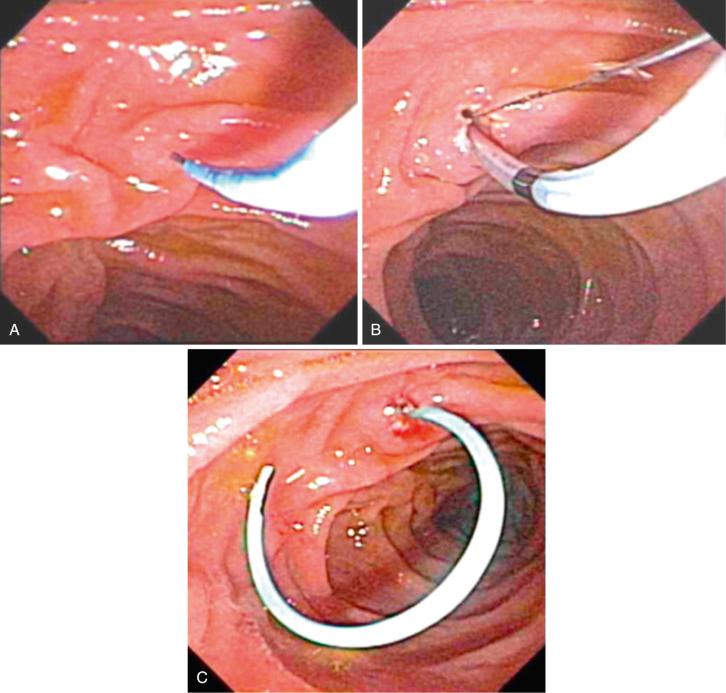
Elevated basal sphincter tone or spasm and ampullary stenosis may obstruct the flow of pancreatic secretions or cause bile reflux into the pancreatic duct, triggering episodes of pancreatitis. Sphincter of Oddi disorders (SODs) are sometimes considered as a possible cause of IRAP in postcholecystectomy patients. Pancreatic SOD is included in the well-known Milwaukee classification, with most IRAP patients falling into the type 2 category (pancreatic pain, recurrent elevations in amylase or lipase, and normal pancreatic duct). There is ongoing debate over the relationship between SOD and pancreatitis, but evidence is mixed regarding a causative relationship. Multiple studies using manometry have shown elevated sphincter pressures ranging from 15% to 72% in patients with IRAP, although the significance of elevated sphincter pressures remains unclear, and hypertension may not translate to a clinical syndrome that responds to biliary and or pancreatic sphincter ablation.
There are no evidence-based guidelines regarding the role of ERCP in diagnosis and treatment of SOD in IRAP. Relief from recurrent attacks occurs in 52% to 89% of patients with manometrically confirmed pancreatic SOD who undergo endoscopic therapy with sphincterotomy or botulinum toxin. In prospective studies, the rates of RAP after endoscopic therapy range from 14% to 48% over a mean follow-up period of 29 to 78 months. The decision to intervene in type 1 pancreatic SOD (i.e., IRAP and a dilated pancreatic duct) is fairly clear-cut. However, most patients fall into the type 2 category, and lack ductal dilation to implicate outflow obstruction. Because of the inherent risk and uncertain effectiveness of endoscopic therapy, it is preferred that the endoscopist meet the patient prior to performing the procedure. This preprocedure consultation allows the establishment of trust and a rapport between the physician and patient, and enables the physician to communicate realistic expectations regarding the risks of the procedure and the likelihood of a response. The risk of post-ERCP pancreatitis is elevated in this group compared to other indications (10% vs. 4%), and is highest for those with pancreatic sphincter hypertension. Many additional patients will require admission for postprocedure abdominal pain, with or without modest enzyme elevations.
Endoscopic approaches to SOD have been heterogeneous, and there are few randomized trials to define the optimal technique and the efficacy of the intervention. Furthermore, outcomes in most studies of endoscopic therapy for IRAP have been variably defined, and many studies have suboptimal follow-up. A common practice has been to perform empiric sphincterotomy (without manometry) in RAP, citing the increased time and risk and lack of precision of sphincter of Oddi manometry (SOM) measurements. However, many experts suggest SOM as a guide for sphincterotomy, especially in cases of suspected pancreatic sphincter hypertension, given the increased risk of pancreatic sphincterotomy. The main argument in favor of SOM is that patients with high pressures have better response rates, whereas those with normal pressures can be spared the additional risk of sphincter ablation because they are unlikely to respond. In addition, it appears that SOM does not add significantly to the risk of the procedure. Indirect tests (e.g., secretin-stimulated EUS, nuclear scintigraphy) have not shown sufficient sensitivity to be alternatives to SOM in ruling out SOD.
Another question is what type of sphincterotomy to perform. The sphincter of Oddi is comprised of three components: common, biliary, and pancreatic sphincter fibers. An EBS may suffice to treat patients with type 2 pancreatic SOD, rather than an endoscopic dual sphincterotomy (EDS), as pancreatic sphincter hypertension is often primarily due to the common fibers rather than the pancreatic fibers. As such, cutting the common fibers may sufficiently decrease pancreatic sphincter pressure to prevent further attacks. Past observational studies have yielded mixed conclusions regarding the necessity of EDS rather than EBS in type 2 pancreatic SOD. A 2012 randomized controlled trial compared EBS and EDS in patients with pancreatic sphincter hypertension. Patients with manometrically confirmed pancreatic sphincter hypertension were randomized to EBS (n = 33) or EDS (n = 36) and followed for a mean of 78 months (interquartile range 23–108 months). There was no difference in the rate of RAP during follow up (48.5% vs. 47.2%, p = 0.20). The rates of RAP following both EBS/EDS were notably high compared to retrospective studies of pancreatic SOD. This interesting finding suggests that sphincter hypertension may not always be the true pathogenic factor in pancreatic SOD, and that underlying genetic factors or other unknown variables may be at play. The investigators also randomized patients with normal SOM (n = 20) to EBS or sham treatment. There was no difference in the rate of RAP observed during follow-up between these two groups (11% vs. 27%, p = non-significant). The results of this study call into question the role of manometry in directing sphincterotomy, and perhaps even the value of a sphincterotomy in RAP. Although sphincter ablation may still be considered on an individualized basis, we believe a prudent strategy is to selectively cannulate the bile duct and perform EBS without preceding manometry. In patients who recur following EBS, pancreatic manometry with or without EDS can be considered as a “salvage” procedure.
Become a Clinical Tree membership for Full access and enjoy Unlimited articles
If you are a member. Log in here